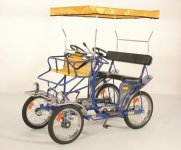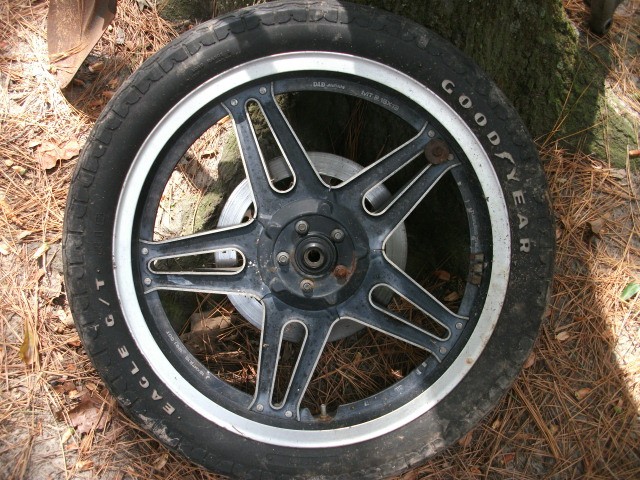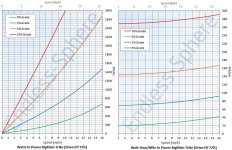John in CR
100 TW
Luke,
It would work on pool table flat, but that can never be the case due to driveways, etc.. Realistically he's looking at a total load of close to 900lbs, so getting him going on is where he'll use all the energy, and for cooling 15mph isn't much better than parked. The low desired speed means low voltage too to avoid riding around a high load low duty cycle, an inefficient heat generating prospect. I can't ever recommend a maybe it will work setup that's all but guaranteed to fail going up a long hill. Putting a motor with a chain or belt drive on the delta trike is so easy to implement under or behind a comfy seat, and it's guaranteed to work. Then you up the voltage and gear it down for a happier motor and a happier rider, so even on moderate inclines the system won't be stressed, because it will be able to generate the power and torque to do it. Also, MidMonster is an easier to fit diameter than common pancake hubbies.
BigRider,
While the system I'd recommend would have a peak power of several kw, that doesn't mean it will use that power all the time. You need something capable of that kind of power when the load demands it. At cruise where the load is low it will put out only the mid 100's of watts needed much of which will depend on your tires, but if you get on an incline of even just a 5% grade then you need over 1kw at the wheel just to maintain 10mph. A 10% grade requires 2kw for 10mph. Even though you don't want to go fast, you don't want to take a week to get up to speed. I'm not talking about acceleration like I have and being able to blast away from traffic when the light turns green, but you do want to get up to speed quickly and get through an intersection safely as well as not waiting for huge gaps in traffic to turn left. I promise that you'll enjoy zippy over sluggish, and gentle on the throttle will accelerate you slowly when you want. Also, when you are forced to a stop on an incline like in a parking garage or a driveway or wherever, you want confidence that the trike can get out of the hole and go.
I think everyone is underestimating the impact of your total load of 800-900lbs, and that's before putting a kid or two or a load of groceries or hardware in the back. Even with 3 common hubmotors, one in each wheel, each will see a load greater than the majority have on their ebikes. Even though 3 motors might work for your needs, I couldn't recommend it in good conscience, because it would be too great a load on the relatively small axles...maybe not when traveling in a straight line, but while turning a trike will put much more weight on the outside rear wheel. It's not just the axles either, because hubmotors aren't designed to take side loads, much less the side loads resulting from a 700lb rider. That will need to be a consideration in your wheel and hub selection. You'll need something designed for a light 4 wheeled vehicle, maybe a golf cart hub with a rim and tire for a trailer, or maybe you can take a rear end from an ATV and mate a differential from a large riding lawnmower or cart. That's the kind of stuff to plan out well before spending money, because you can't just slap bicycle stuff on there like normal size people can get away with on their trikes.
Sorry, the beginnings of a book-like post again, but your needs are atypical, but not too different from a trike build to put a family on, something brewing in the back of my mind for a couple of years.
John
It would work on pool table flat, but that can never be the case due to driveways, etc.. Realistically he's looking at a total load of close to 900lbs, so getting him going on is where he'll use all the energy, and for cooling 15mph isn't much better than parked. The low desired speed means low voltage too to avoid riding around a high load low duty cycle, an inefficient heat generating prospect. I can't ever recommend a maybe it will work setup that's all but guaranteed to fail going up a long hill. Putting a motor with a chain or belt drive on the delta trike is so easy to implement under or behind a comfy seat, and it's guaranteed to work. Then you up the voltage and gear it down for a happier motor and a happier rider, so even on moderate inclines the system won't be stressed, because it will be able to generate the power and torque to do it. Also, MidMonster is an easier to fit diameter than common pancake hubbies.
BigRider,
While the system I'd recommend would have a peak power of several kw, that doesn't mean it will use that power all the time. You need something capable of that kind of power when the load demands it. At cruise where the load is low it will put out only the mid 100's of watts needed much of which will depend on your tires, but if you get on an incline of even just a 5% grade then you need over 1kw at the wheel just to maintain 10mph. A 10% grade requires 2kw for 10mph. Even though you don't want to go fast, you don't want to take a week to get up to speed. I'm not talking about acceleration like I have and being able to blast away from traffic when the light turns green, but you do want to get up to speed quickly and get through an intersection safely as well as not waiting for huge gaps in traffic to turn left. I promise that you'll enjoy zippy over sluggish, and gentle on the throttle will accelerate you slowly when you want. Also, when you are forced to a stop on an incline like in a parking garage or a driveway or wherever, you want confidence that the trike can get out of the hole and go.
I think everyone is underestimating the impact of your total load of 800-900lbs, and that's before putting a kid or two or a load of groceries or hardware in the back. Even with 3 common hubmotors, one in each wheel, each will see a load greater than the majority have on their ebikes. Even though 3 motors might work for your needs, I couldn't recommend it in good conscience, because it would be too great a load on the relatively small axles...maybe not when traveling in a straight line, but while turning a trike will put much more weight on the outside rear wheel. It's not just the axles either, because hubmotors aren't designed to take side loads, much less the side loads resulting from a 700lb rider. That will need to be a consideration in your wheel and hub selection. You'll need something designed for a light 4 wheeled vehicle, maybe a golf cart hub with a rim and tire for a trailer, or maybe you can take a rear end from an ATV and mate a differential from a large riding lawnmower or cart. That's the kind of stuff to plan out well before spending money, because you can't just slap bicycle stuff on there like normal size people can get away with on their trikes.
Sorry, the beginnings of a book-like post again, but your needs are atypical, but not too different from a trike build to put a family on, something brewing in the back of my mind for a couple of years.
John









